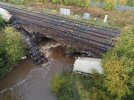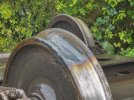Ah yes that’ll be it. I hadn’t taken notice of when it happened but that would confirm that it was 2H99 that was cancelled.2H99 surely?
My bet would be on 158793 and 158904 being stuck in Carlisle.
They arrived on 2H94 1648 Leeds to Carlisle - https://www.realtimetrains.co.uk/service/gb-nr:G90232/2022-10-19/detailed#allox_id=0 - this passed Petteril Bridge Junction at 19:28
2H99 was due to depart Carlisle at 20:13 (which was cancelled from Carlisle and restarted at Appleby around 80L).
The freight derailment happened between the arrival of 2H94 and departure of 2H99
It looks like 2H96 terminated at Appleby and formed 2H99 from there to Skipton. I’m guessing the crews were taxied between Carlisle and Appleby and vv.
Realtime Trains | 2H99 2055½ Appleby to Skipton | 19/10/2022
Real-time train running information for 2H99 2055½ departure from Appleby to Skipton on 19/10/2022. From Realtime Trains, an independent source of train running info for Great Britain.




